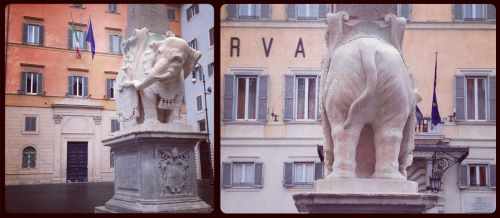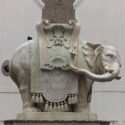Yes, you read this correctly!! Minerva’s “chick” is an elephant. Only in Rome, a chick can turn into an elephant, or is it the other way round? As is well known, Romans love to give nicknames to everyone and everything….even statues. This is the case of “Minerva’s chick” located right behind the Pantheon. It is indeed a bizarre way of calling the small stone elephant holding an obelisk. Read more on why Minerva’s “chick” is an elephant. Take one of our TOURS. We’d be glad to show you the incredible story of why Minerva’s “chick” is an elephant.
Minerva’s Chick
The monument (a small elephant carrying an obelisk) faces the beautiful medieval church of Santa Maria sopra Minerva of the Dominican order. The name – sopra Minerva, literally “above Minerva”- derives from the fact that it was built on the remains of a former temple dedicated to Minerva, the goddess of wisdom.
The history of the statue
In 1665, a small obelisk, about 5.5 metres high, with hieroglyphic inscriptions on all four sides, was found in the garden belonging to the Dominican convent attached to the church. It was one of the many decorations of a huge place of worship dedicated to the goddesses Isis and Serapis. This cult had many followers among the Romans.
Pope Alexander VII decided to have it erected in front of the church of Santa Maria. In order to choose a base for the monument, several renowned architects submitted their designs. One of them was a Dominican priest, Father Domenico Paglia.
According to his design, the obelisk was to rest on six small hills with a dog at each of the four corners. The pope rejected the project. He wanted a symbol of Divine Wisdom, recalling the ancient meaning of the place.
Gianlorenzo Bernini was therefore approached. He devised a suitable base for the obelisk. He proposed an elephant the symbolic representation of strength. The inscription on the side of the statue reads: “…a strong mind is needed to support a solid wisdom”.
However, in Bernini’s original design, the animal had no support. This meant that so the weight of the obelisk would have rested entirely on the elephant’s legs. Father Paglia, rather envious after his idea was rejected, objected to this solution, stating that the weight of the obelisk would make the elephant collapse. The friar suggested to insert a stone cube under the belly of the elephant.
Bernini fiercely opposed to this change, but the pope decided that the support should be added.
Bernini had to accept. He attempted to disguise the rude stone cube by sculpting an elaborate elephant’s caparison to hide it. Despite the attempt, the statue looked very heavy overall.
Why do Romans call it the “chick” when it is an elephant?
After its erection in the square on 11 July 1667 (in the meantime the pope had been dead for some forty days), people began to call it the “Porcino” della Minerva. The word “porcino” in roman slang means “pig”. This derived from the fact that the elephant is short and fat and looks more like a piglet than an elephant. Later the name changed from “porcino” to “pulcino or purcino”, for a simple phonetic modification.
Having lost the memory of the event over time, “porcino” was probably confused in the general knowledge, with “purcino” which is the Roman dialectal form for “chick”. And this is the name by which it is still known today.

Minerva’s chick – Bernini’s sculpture in Piazza di Santa Maria sopra Minerva
A curiosity – Bernini’s revenge
Bernini meditated a revenge against the Dominican who had dared to challenge him. In the final version of the statue, currently standing in front of the Church of Santa Maria Sopra Minerva, he designed the elephant so that it pointed its rear (with its tail slightly out of position) in the direction of the nearby convent. This was done so that Father Paglia and the other friars, were greeted by this “unpleasant” view every time they looked out of their windows! In addition, the elephant looks away from the Church to underline how displeased Bernini was with his commissioner!

